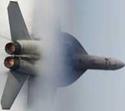Supersonic Flight
|
S |
upersonic flight is flight faster than the speed of sound. The speed of sound in air is about 761 miles per hour (1,225 kilometers per hour) at sea level. Most planes fly more slowly than this, but the fastest can fly at two or three times the speed of sound. Many missiles fly at two to five times the speed of sound.
Designing Supersonic Aircraft
As an aircraft approaches the speed of sound, the drag it experiences increases sharply. Aircraft designers deal with
О An F/A-18F Super Hornet breaks the sound barrier during a 2006 U. S. Air Force demonstration.
|
|
this problem by making supersonic aircraft slender, with swept-back wings and very powerful engines to overcome the extra drag.
The most powerful engines are noisier, however, and they burn fuel faster. These factors make it difficult to design a supersonic airliner, also called a supersonic transport (SST). A slender aircraft cannot hold many passengers, and noisy engines are unpopular with people who live near airports. In addition, faster burning of fuel means that an airplane cannot fly as far. For these reasons, all the supersonic aircraft flying today are military aircraft. There have been only two supersonic airliners in the past: the British/French Concorde and the Soviet Tupolev Tu-144.
The Altitude Factor
One way to reduce the drag that a supersonic plane experiences is to fly much higher than other aircraft. The thinner air at higher altitudes causes less drag. Subsonic airliners fly at altitudes of around 30,000 to 40,000 feet (9,100 to 12,1200 meters), while the supersonic passenger airplane Concorde flew at altitudes of
50,0 to 60,000 feet (15,250 to 18,300 meters).
The atmosphere protects us from harmful radiation from space. The higher an aircraft flies, the more of this atmospheric protection it loses. Concorde received double the radiation dose of sub-
![]()
![]()

![]()
![]()
![]()
![]()
![]()
![]()
![]()
![]() sonic airliners, but it also flew more than twice as fast, so the exposure to radiation was about the same. However, storms on the Sun (known as solar flares) can produce a sudden increase in radiation in the upper atmosphere. One instrument on Concorde was a radiation meter. If the radiation levels were too high, an alarm sounded, and the airplane was required to descend to below 47,000 feet (14,330 meters), where it had more protection from the atmosphere above it.
sonic airliners, but it also flew more than twice as fast, so the exposure to radiation was about the same. However, storms on the Sun (known as solar flares) can produce a sudden increase in radiation in the upper atmosphere. One instrument on Concorde was a radiation meter. If the radiation levels were too high, an alarm sounded, and the airplane was required to descend to below 47,000 feet (14,330 meters), where it had more protection from the atmosphere above it.











